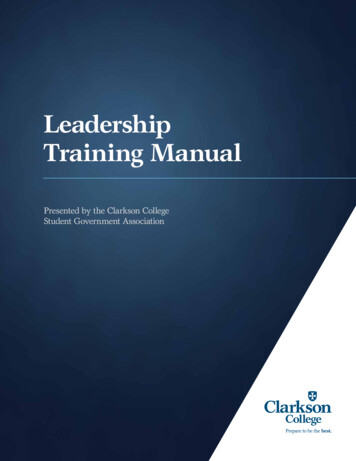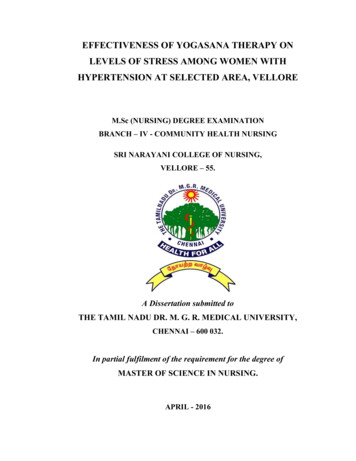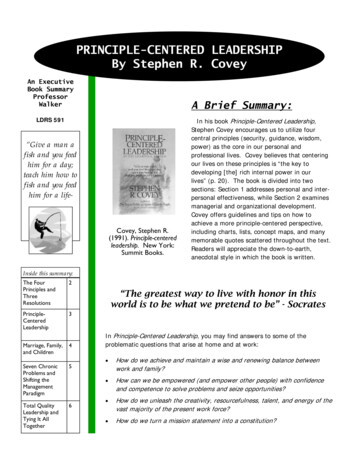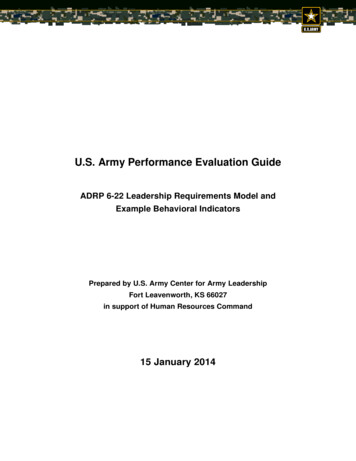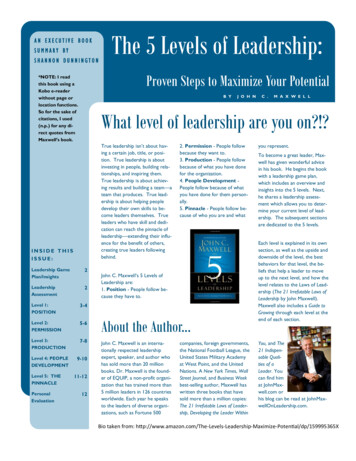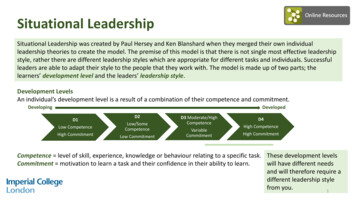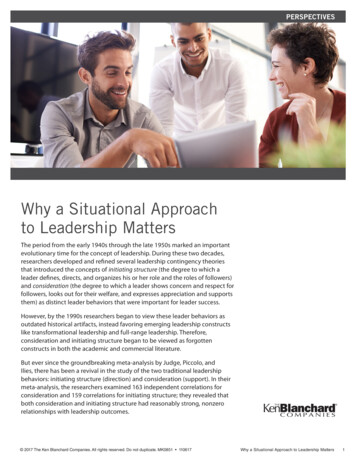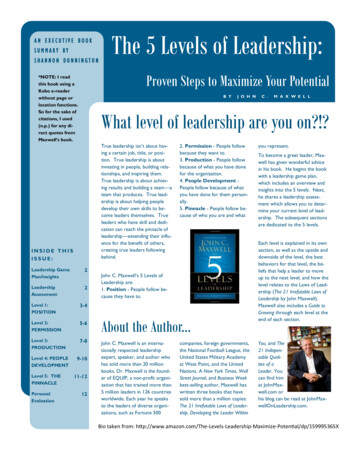
Transcription
AN EXECUTIVE BOOKSUMMARY BYSHANNON DUNNINGTONProven Steps to Maximize Your Potential*NOTE: I readthis book using aKobo e-readerwithout page orlocation functions.So for the sake ofcitations, I used(n.p.) for any direct quotes fromMaxwell’s book.B YTrue leadership isn’t about having a certain job, title, or position. True leadership is aboutinvesting in people, building relationships, and inspiring them.True leadership is about achieving results and building a team—ateam that produces. True leadership is about helping peopledevelop their own skills to become leaders themselves. Trueleaders who have skill and dedication can reach the pinnacle ofleadership—extending their influence for the benefit of others,creating true leaders followingbehind.Leadership GamePlan/Insights2LeadershipAssessment2Level 1:POSITION3-4Level 2:PERMISSION5-6Level 3:PRODUCTION7-8Level 5: THEPINNACLEPersonalEvaluationJ O H NC .M A X W E L LWhat level of leadership are you on?!?INSIDE THISISSUE:Level 4: PEOPLEDEVELOPMENTThe 5 Levels of Leadership:9-1011-12122. Permission - People followbecause they want to.3. Production - People followbecause of what you have donefor the organization.4. People Development People follow because of whatyou have done for them personally.5. Pinnacle - People follow because of who you are and whatJohn C. Maxwell’s 5 Levels ofLeadership are:1. Position - People follow because they have to.About the Author.John C. Maxwell is an internationally respected leadershipexpert, speaker, and author whohas sold more than 20 millionbooks. Dr. Maxwell is the founder of EQUIP, a non-profit organization that has trained more than5 million leaders in 126 countriesworldwide. Each year he speaksto the leaders of diverse organizations, such as Fortune 500companies, foreign governments,the National Football League, theUnited States Military Academyat West Point, and the UnitedNations. A New York Times, WallStreet Journal, and Business Weekbest-selling author, Maxwell haswritten three books that havesold more than a million copies:The 21 Irrefutable Laws of Leadership, Developing the Leader Withinyou represent.To become a great leader, Maxwell has given wonderful advicein his book. He begins the bookwith a leadership game plan,which includes an overview andinsights into the 5 levels. Next,he shares a leadership assessment which allows you to determine your current level of leadership. The subsequent sectionsare dedicated to the 5 levels.Each level is explained in its ownsection, as well as the upside anddownside of the level, the bestbehaviors for that level, the beliefs that help a leader to moveup to the next level, and how thelevel relates to the Laws of Leadership (The 21 Irrefutable Laws ofLeadership by John Maxwell).Maxwell also includes a Guide toGrowing through each level at theend of each section.You, and The21 Indispensable Qualities of aLeader. Youcan find himat JohnMaxwell.com orhis blog can be read at JohnMaxwellOnLeadership.com.Bio taken from: ze-Potential/dp/159995365X
PAGELeadership Game Plan:2“Leadership is a process, not a position.There was a timewhen people usedMaxwell is very passionateabout leadership. He’s a motivational teacher who tries tohelp people reach their potential. He convinces readers thathis book is for them because“it works!” He claimed the 5levels of leadership:the terms leadershipand management interchangeably. Ithink most peoplenow recognize thatverb and not a noun Breaks down leadinginto understandablesteps Provides a clear gameplan for leadership development Aligns leadership practices, principles, andvaluesthere is a significantdifference betweenthe two. Management is at its bestwhen things stay the Provides a clear picture ofleadership Defines LEADING as asame” (n.p).Insights into the 5 Levels:Maxwell shares 10 insightsthat help the reader understand how the levels are related to one another:4.1.You can move up a levelbut you never leave theprevious one behind5.2.You are not on the samelevel with every person6.The higher you go, thegreater the return3.The higher you go, theeasier it is to lead7.Moving farther up alwaysrequires further growth“Everything risesand falls onleadership” (n.p.).The higher you go, themore time and commitment is required to win alevelMoving up levels occursslowly, but going downcan happen quickly8.Not climbing the levelslimits you and your people9.When you change positions or organizations,you seldom stay at thesame level10. You cannot climb thelevels aloneLeadership Assessment:Maxwell provides a four-part questionnaireto help readers understand where they arein the leadership journey. Readers areencouraged to assess their current level ofleadership before continuing to read moreof the book.Part Three—Leadership AssessmentTeam Member’s Point of View (askeach person who reports to you to fill outthe worksheet—Yes or No questions foreach level. This part can be done anonymously)Part One—Leadership Level Characteristics (Answer True or False on 10Statements for each level)Part Four—Current Leadership LevelAssessment (put it all together and tallythe results. Instructions on how to do thisare included.)Part Two—Individual Team MemberAssessment-Leader’s Point of View(for each person you oversea, answer Yesor No to questions for each level)THE5LEVELSOFLEADERSHIP
LEVEL 1: ctiveleadership-development/Position is the entry level of leadership. Every leader starts here. It isLeadership the foundation every leader buildsupon.is morethan justhaving aposition.“Positional leadership is based onthe rights granted by the positionand title. Nothing is wrong withhaving a leadership position. Everything is wrong with using positionto get people to follow. Position is a poorsubstitute for influence” (n.p.).The Upside of Level 11.A leadership position isusually given to peoplebecause they have leadership potential—once youhave been given the invitationto lead something, you needto celebrate because someoneThe people of Level 1 have subordinates—not team members—and they rely heavilyon rules, policies, and regulations to control their people. These “subordinates”will only do what is required of them andnothing more.Anyone can be given or appointed to aposition. Because of the ease of obtaininga position, this level does not require ability and effort to achieve.Level 1 people may be bosses, but they arenever leaders. They do not have the influencethat is needed to lead.People follow you because theyhave to.Maxwell claims that if you are newto leadership and you receive aposition, there are four things tocelebrate:3invitation to grow as aleader—one main requirement of receiving a leadershipposition is personal growth. Ifa leader is not willing to grow,then not much leading willtake place.in authority believes in you.2.3.A leadership positionmeans authority is recognized—with position and titlecomes some level of authorityor power. Leaders mustprove themselves beforethey’re given much power andauthority.4.A leadership position is anA leadership position allows potential leaders toshape and define theirleadership—this allows thepeople invited to take aleadership position the opportunity to choose the kindof leader they want to be.“Leadership ismuch lessabout whatyou DO, andmuch moreabout who youARE.”The Downside of Level 11.2.Having a leadership position 3.is often misleading—eventhough you are given a certaintitle or position, it does notautomatically make you a lead4.er.Leaders who rely on position to lead often devaluepeople—positional leadersplace very high value on theirposition, and not all the otherimportant aspects of leading.5.Positional leaders feed onpolitics—”Positional leadersfocus on control instead of contribution” (n.p.).Positional leaders placerights over responsibilitiesPositional leadership is oftenlonely—since Level 1 leadersmostly only care about themselves and their positions, it becomes “lonely at the top”!6.7.8.Leaders who remain positional get branded andstranded—if position is used inthe wrong way, Level 1 leadersbecome branded as positionalleaders and are often stranded onTurnover is high for positional leadersPositional leaders receivepeople’s least, not theirbest—Level 1 leaders arethe weakest of all leadersand give their least. Asa result, their people givetheir least as well.—FrancesHesselbein“Leadership isaction, not position” (n.p.).
PAGEBest Behaviors on Level 14Laws of Leadershipat the Position Level: In order to help you make themost of your leadership position while shifting to the nextlevel, Maxwell suggests you dothree things:The Law of theLID—Leadershipability determines a person’slevel of effectiveness Stop relying on position to push people—don’t use your position toget things done. Youneed to use other skills.2.Trade entitlement forThe Law of PROCESS—Leadership develops daily, notin a day 1.movement—don’t rely oyour title to lead people butkeep your people and theorganization moving forward.Moving forward to its vision.3.Leave your position andmove toward your people—don’t expect your people to come to you for theirneeds and wants, but go tothem. Initiate.This is how Level 1 leadersthink Top-down: “I’m over you.”Separation: “Don’t let peopleget close to you.”Image: “Fake it till you make it.”Strength: “Never let ‘em seeyou sweat.”Selfishness: “You’re here to helpme.”Power: “I determine your future.”Intimidation: “Do this or else!”Rules: “The manual says ”The Law ofNAVIGATION—Anyone cansteer the ship,but it takes aBeliefs That Help a Leader Move Up to Level 2leader to chartthe course1.Titles are not enough2.People—not position—are a leader’s most valuable asset3.A Leader doesn’t need tohave all the answers4.A good leaders alwaysincludes othersForDiscussion:Why do leaderswho neverprogressbeyond Level 1experience highturnover ratesof their teams?Guide to Growing through Level 1Maxwell suggests the following 10 tips tohelp you plan your growth:6. Shift from Rules to Relationships1, Thank the people who invited you intoleadership8. Don’t mention your title or position2. Dedicate yourself to Leadership Growth3. Define your Leadership4. Shift from Position to Potential5. Focus on the VisionTHE5www.cartoonstock.comIn order to move up, you mustchange your thinking aboutleadership. Maxwell suggestsinternally embracing the following four statements beforeyou will be able to move fromLevel 1 to Level 2:LEVELSOFLEADERSHIP7. Initiate contact with your team members9. Learn to say, “I Don’t Know”10. Find a Leadership Coach
“The key to moving up to thePermission level is having theright attitude” (n.p.).http://www.iblogoakville.com/?p 1462People follow you because theywant to.PAGE5LEVEL 2: PERMISSIONhow to get along with them, and findingout who their people are. As a result,the followers find out who their leadersare, and in turn this builds solid, lastingrelationships.Relationships, relationships,relationships. The key toBuildingLevel 2 is relationships. Levelrelation2 is also about developingships isinfluence with your people.key.Liking your people and treating them like individuals withvalue, influence is created.Trust is also developed. The environmentalso becomes much more positive than thatwith a Level 1 leader.Leaders may be tempted tostop at Level 2, but there ismore to leadership than justrelationships!Level 2 leaders are so concerned aboutpreserving their position, but their concernis getting to know their people, figuring out“You can likepeoplewithoutleading themThe Upside of Level 2Since Level 2 requires relationshipbuilding, there are many upsides toLevel 2.1.Leadership Permissionmakes work more enjoyable—Level 2 leaders shift theirfocus from me to we. SinceLevel 2 leaders put their focuson relationships and winningpeople over with interactions,this creates a positive workingbut youcannot leadpeople wellturn, their people listen tothem.environment.2.Leadership Permissionincreases the energy level—when you spend time withpeople you know and like, itgives you energy!3.Leadership Permissionopens up channels of communication—Level 2 leaderslisten to their people and in4.Leadership Permissionfocuses on the value ofeach person—good relationships are built when peoplevalue and respect one another.5.Leadership Permissionnurtures trust—in order tomaintain these essential relationships, trust must be built!without likingthem” (n.p.).The Downside of Level 2Maxwell points out that relational peopleoften ask what possibly could be thedownside of developing relationships,building trust, and gaining people’s permission to lead them? The positives outweigh the negatives of course, but thereare still downsides to Level 2.1.2.Permission Leadership appears toosoft for some peopleLeading by Permission can be frus-trating for achievers3.Permissional Leaders can be takenadvantage of4.Permission Leadership requires openness to be effective5.Permission Leadership is difficult forpeople who are not naturally likable6.Permission Leadership forces you todeal with the whole personhttp://www.impactfactory.com/tailored leadership.htmlFor Discussion:Why is “openness” required forpermission leadership to beeffective?
PAGE6Best Behaviors on Level 2Laws of Leadershipat the PermissionLevel: How can you gain people’spermission? Maxwell suggeststhe following:The Law of theINFLUENCE—The true measure of leadershipis influence—nothing more,1.Connect with yourselfbefore trying to connect with others—youmust know yourself first,get along with yourselffirst, be honest with yourself, change yourself firstbefore trying to changenothing less The Law of ADDITION—Leaders add value by servingothers ID—Trust is thefoundation ofThe Law ofMAGNETISM—Who you are isThe Law of1.CONNECTION—Leaderstouch a heartRelationships aloneare not enough—there’s more to leadership than influence, nowyou have to take yourpeople somewhere!before they askfor a hand 3.4.In order to win a higher levelof leadership, Maxwell remindshis readers of the following:who you attract 2.Become the chief en-Move Up to Level 3Leadership 5. Strike a balance between care and candor—it isin a leader’s best interest toDevelop a peopleshow care AND candor to othoriented leadershipers. Just having one or the otherstyle—use a personalis not enough, there must be atouch: listen, learn, and then balance between the two in orlead!der to maintain those positiverelationships.Practice the goldenrule—Treat others as youwant others to treat youothers, and take a responsibility for yourselfBeliefs That Help a LeaderThe Law of SOL-2.The Law of BUYBuilding relationshipscourager of your team—encouraging words go a longways.require twofoldgrowth—as well asgrowing toward each other, people must grow witheach other.3.Achieving the vision asa team is worth riskingthe relationships—riskfor the sake of the biggerpicture.This is how Level 2 leadersthink Side by Side: “Let’s work together.”Initiation: “I’ll come to you.”Inclusion: “What do you think?”Cooperation: “Together we canwin.”Servanthood: “I’m here to helpyou.”Development: “I want to addvalue to you.”Encouragement: “I believe youcan do this!”Innovation: “Let’s think outsidethe box.”-IN—People buyinto the leader,then the visionGuide to Growing through Level 2oneinabillionconsulting.blogspot.com“Leadership isinfluence, nothingMaxwell suggests the following to help youplan your growth:5.Evaluate where you are with yourteam1.Be sure you have the right attitudetoward people6.Accept the whole person as part ofleading2.Connect with yourself—selfawareness, self-image, self-honesty, self-improvement, and self-responsibility7.Make FUN a goal8.Give people your undivided attention9.Become your team’s Encourager-inChief3.Understand where you’re comingfrom4.Express value for each person on yourteammore, nothingless” (n.p.).THE5LEVELSOFLEADERSHIP10. Practice Care and Candor
PAGELEVEL 3: esigner.htmlPeople follow because of whatyou have done for the organization.There’s more to being agood leader than creatinga pleasant and positiveworking environment.Good leaders get thingsdone! They produceresults.It is on Level 3 that leading andinfluencing others becomes fun!Level 3 leaders can become changeagents. They can: tackle tough problems andface thorny issues, make the difficult issues thatOn Level 3, leaders gaininfluence and credibility. Positive thingshappen with a Level 3 leader: work getsdone, goals are achieved, morale improves, profits go up, turnover goesdown, and momentum kicks in!will make a difference , and take their people to anotherlevel of effectiveness. (n.p.)Making ThingsHappen SeparatesReal Leaders fromWannabesThe Upside of Level 3With strong relationships as thefoundation for Level 3, these leaders get results and as a result improve their team and organization.Maxwell explains the following 6upsides:1.2.Leadership Productiongives credibility to theleader—”There are twotypes of people in the businesscommunity: those who pro-1.Being productive canmake you think you’re aleader when you’re not—inorder to be a good leader, youneed to do things with and forLeadership Productionbrings clarity and reality tothe visionduce results and those whogive you reasons why theydidn’t.”—Peter Drucker4.Leadership Productionmodels and sets the standard for others visually—Level 3 leaders are examplesto their people, so theirproductivity sets the standardto their people as well.5.Leadership Productioncreates momentum—there’s momentum takes,breakers, and makers.whichwould you rather be?!?6.Leadership Production isthe foundation for teambuildingThe Downside of Level 3Even though organizational achievement becomes easier in Level 3, theactual leadership itself does not.Maxwell discovered four maindownsides:3.others, not just yourself!2.Productive leaders feel aheavy weight of responsibility for results—this is oneof the costs of effective leadership.3.Production Leadershiprequires making difficultdecisions4.Production LeadershipLeadership Productionsolves a multitude of problems“The credibility ofa Level 3 leadercan be summed upin one word:example” (n.p.).demands continual attention to Level2—even thoughLevel 3 leadersare responsibleresults, this doesnot mean thatthey stop caringabout their people. Relationshipscontinue to behttp://www.leadership-expert.co.uk/built, maintained,and deepened.7
PAGE8Best Behaviors on Level 3Laws of Leadership atthe Production Level: Maxwell suggests the following for making themost of Production in Leadership:The Law of RESPECT—Peoplenaturally followleaders strongerthan themselves The Law of MAG-1.Understand how your personal giftedness contributes to the vision—figure outwhere your true strengths lie.2.Cast vision for what needs to be accomplished—having a clear and communicated vision contributes to the productivityof the team.NETISM The Law of the3.PICTURE—People do whatpeople see Maxwell suggests embracingthe following four ideas onLevel 3. Understanding thesestatements will help you moveto Level 4.The LAW of PRI-is not necessarilyaccomplishment1.Production is notenough—don’t just settle for production, but tryto achieve higher levels tohelp change others’ lives.2.People are an organization’s most appre-The Law of SACRIFICE—A leadermust give up toBe willing and ready to be a changeagent—”Progress always requireschange” (n.p.).6.Never lose sight of the fact that results are your goalThe Law of BUYINFor Discussion:How does one balanceleading others andbeing productive at thesame time?THEciable asset—so value,challenge, and developthem , as well as helpthem grow!3.Growing leaders is themost effective way toaccomplish the vision—invest in your people and your organizationwill be better.4.People development isthe greatest fulfill-ment for a leader—helping people becomebetter and greater is sucha joy. “Few things in lifeare better than seeingpeople reach their potential” (n.p.).Guide to Growing through Level 3go up 5.The Law of theORITIES—Leaders understand that activity Prioritize the things that yield highreturn—the key to being productive isprioritizing. Effective Level 3 leaders notonly get lots done, but they get the rightthings done.Beliefs That Help a Leader Move Up to Level 4BIG MO—Momentum is aleader’s bestfriend 4.The Law of VICTORY—Leadersfind a way for theteam to win Begin to develop your people into ateam—Level 3 people must work together,and production makes this possible.5LEVELSmomentumMaxwell suggests the following to help youplan your growth:8.Practice the Pareto Principle1.Be the team member you want onyour team9.Accept your role as Change Agent2.Translate personal productivity intoleadership3.Understand everyone’s productivityniche4.Cast vision continually5.Build your team6.Use momentum to solve problems7.Discern how team members affectOF10. Don’t neglect Level 2LEADERSHIPhttp://www.leadership-expert.co.uk/
PAGE9LEVEL 4: PEOPLE DEVELOPMENThttp://www.ehow.com/about 6292185 teambuilding-leadership-development.htmlLevel 4 leaders have the ability toDeveloping empower others. “They usetheir position, relationships, andpeople toproductivity to invest in theirbecomegreat lead- followers and develop them untilthose followers become leadersersin their own right” (n.p.). Theresult? Reproduction! Level 4leaders reproduce themselves.each other better, and therefore strengthens loyalty.2.Performance increases—since thereare more leaders on the team, everyone’sperformance improves.Maxwell suggests that two things always happenon Level 4:People follow because of whatyou have done for them.1.There is a very high level of teamwork—high investment in people deepensrelationships, which helps people to know“Level 4leaders changeThe Upside of Level 41.2.People Development setsyou apart from most leaders—Level 3 leaders focus onincreasing production, Level 4leaders focus on growing thecompany by growing the people in it.zation the best chance forsustaining success and growth.3.People Development assures that growth can besustained—developing andtraining people gives an organi-People Development empowers others to fulfilltheir leadership responsibilities—”If your actions inspire others to dream more,learn more, do more and become more, you are a leader”—John Quincy Adamsthe lives of thepeople theylead” (n.p.).4.People Development empowers the leader to leadlarger—sharing leadershipwith others gives you backtime, allowing you to do themost important things.5.People Development provides great personal fulfillment—giving to others is oneof the greatest satisfactions inlife.The Downside of Level 4People Development requires ahigh level of maturity and skill. People Development is not easy, andtherefore there are some downsides to this level.1.Self-centeredness cancause leaders to neglectPeople Development—selfish leaders do not reach alevel of maturity, and as aresult, people developmentdoes not happen.2.3.Insecurity can make leaders feel threatened byPeople Development—doyou have ego, control, or trustissues?!?Shortsightedness can keepleaders from seeing theneed for People Develop-ment—be willingto adopt a longterm mindset.4.Lack of commitment can keepleaders fromdoing the hardwork of ist-of13565586/Putting the “D”evelopment inLeadership!
PAGEBest Behaviors on Level 410Laws of Leadershipat the People Development Level: The Law of AD-Maxwell says “Only leaderscan develop other people tobecome leaders Nobodyreally understands leadershipuntil he or she does it” (n.p.).DITIONHe claims:The Law of TheIt Takes a Leader toKNOW a Leader (Recruiting& Positioning)The Law of PROCESS INNER CIRCLE—A leader’spotential is determined bythose closest toIt Takes a Leader toSHOW a Leader (Modeling3.Modeling—showingothers how to lead4.Equipping—helpingothers do their jobs well5.Developing—teachingthem to do life well6.Empowering—enablingpeople to succeed7.Measuring—evaluatingthose whom you developto maximize their effortsand Equipping)It Takes a Leader toGROW a Leader(Developing, Empowering, andMeasuring).1.2.Recruiting—find thebets people possiblePositioning—placing theright people in the rightpositionhim The Law of EM-Beliefs That Help a Leader Move Up to Level 5POWERMENT—Only secureleaders givepowers to others The Law of EXPLOSIVEGROWTH—Toadd growth, leadfollowers—tomultiply, leadleaders 1.The Law of BUY-INFor Discussion:In what ways canyou make peopledevelopment alifestyle? Howwould this lifestylechange your team,business ororganization?THE5The highest goal ofleadership is to develop leaders, not gainfollowers or do theirwork—developing othersshould be your goal atthis point.a job commitment2.To develop leaders,you must create aleadership culture—aculture that cultivatesLevel 5 leaders is one thatwill champion, teach,practice, coach, and reward leadership.3.Developing leaders is alife commitment, notGuide to Growing through Level 4Maxwell suggests the following to help youplan your growth:LEVELS7.Never work alone8.Blend the soft and hard sides of developmentTake responsibility for energizing others1.Be willing to keep growing yourself2.Decide that people are worth theeffort9.3.Work through your insecurities4.Recruit the best people you can todevelop10. Remain approachable as a leader, rolemodel, and coach5.Commit to spend the time needed todevelop leaders6.Create a personal development ext-positivestep/Maxwell suggests embracingthe following beliefs beforeattempting to climb to the lastlevel. Understanding thesestatements will help you havethe best chance at making it atthe top.
PAGE11LEVEL 5: le follow you because ofwho you are and what you represent.Of course, Level 5 is the highest and most difficult level.Not many people achieve thisTakinglevel, and if they do, it’s beothers tocause they are naturally giftedthe top!leaders. Most people canachieve Levels 1 through 4, butLevel 5 requires a lot of effort,skill, intentionality, and a high level of talent.Level 5 leaders develop their people to become Level 4 leaders. Many leaders don’tmake it to Level 5 because it requires them todevelop followers rather than simply lead followers. Developing followers to lead on theirown takes a lot of work and effort and isvery difficult.“Developing leaders to the point wherethey are able and willing to develop otherleaders is the most difficult leadership taskof all” (n.p.).Level 5 leaders develop Level 5 organizations. Level 5 leaders create opportunitiesthat other leaders don’t.Their leadership gains apositive reputation, thuscreating a great deal ofrespect.“The highestleadershipThe Upside & Downside of Level 5accomplishmentMaxwell explains that while thereshould be many upsides and veryfew to no downsides of Level 5,this is not the case on the Pinnaclelevel.Level 4” (n.p.).2.3.Pinnacle Leadership creates a legacy within theorganizationDOWNSIDES of Level5—It’s not all about you1.1.Pinnacle Leadership creates a Level 5 OrganizationBeing on the Pinnacle canmake you think you’vearrived—you’re not doneother leaders togrowing, leading, or learning.2.Being on the Pinnacle canlead you to believe yourown press—don’t get carriedaway with your power andposition.3.Being on the Pinnacle canmake you lose focus—remain focused on your purpose and vision, and continueleading.Pinnacle Leadership provides an extended platform for leadingUPSIDES of Level 5—Your influence is a wonderful thing!is developingBest Behaviors on Level 5To be successful on the highest level of leadership,embrace the following:1.Make room for others at the top—”Theultimate leader is one who is willing to develop people to the point that they eventuallysurpass him or her in knowledge and ability.””—Fred A. Manske Jr.2.Continually mentor potential Level 5leaders3.Create an inner circle that will keep yougrounded—”those closest to leaders determine their potential” (n.p.).4.Do things for the organization thatonly Level 5 leaders can do5.Plan for your succession—leave a successor, and leave before you have to.6.Leave a positive legacy—make the rightdecisions along the way so a positive legacycan be left!http://www.nwlink.com/ donclark/leader/mentoring.html“The leadership journey hasthe potential to take individuals through a lifelong processin three phrases: learn, earn,return” (n.p.).
PAGE12Help Others Move Up to Levels 4 & 5Laws of Leadershipat the Pinnacle Level: The Law of RESPECT The Law of INTUITION—Leaders evaluateeverything withIn order to make the most of your influence onLevel 5, Maxwell suggests the following to helpyour best leaders reach their leadership potential:3.Use your own crucible moments asguidelines to teach others—share yourexperiences and lessons learned fromthem.1.Identify and create the crucial leadership lessons they must learn4.2.Look for unexpected crucible moments they can learn from—look forteachable moments in every dayExpose them to other people andorganizations that will impact them—this is part of your job to help create anddevelop leadersa leadership bias The Law of TIMING—When tolead is as important as whatGuide to Being Your Best at Level 5to do and whereto go The Law of LEGACY—A leader’slasting value ismeasured bysuccession The Law of EXPLOSIVEGROWTHMaxwell gives suggestions onhow to help you grow as aleader and develop others tobecome Level 4 leaders.5.Create a superchargedleadership developmentenvironment6.Create room at the top1.Remain humble andteachable7.Develop your top leaders2.Maintain your core focus8.Plan your succession3.Create the right innercircle to keep yougrounded9.Plan your legacy4.Do what only you can do10. Use your leadership success as a platform forsomething greaterFor Discussion:Do you believe there’splenty of room at the to
Jun 05, 2015 · level relates to the Laws of Lead-ership (The 21 Irrefutable Laws of Leadership by John Maxwell). Maxwell also includes a Guide to Growing through each level at the end of each section. True leadership isn’t about hav-ing a certain job, title, or posi-tion. True leadership is about investin
